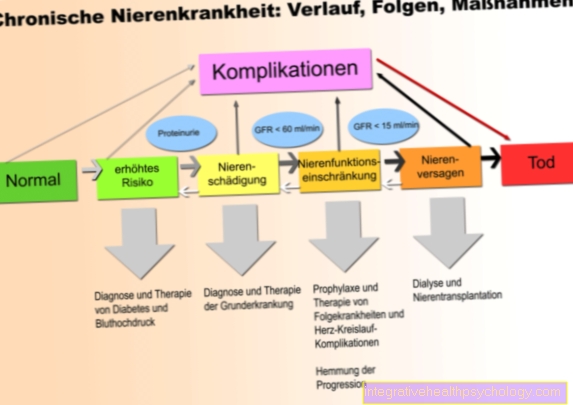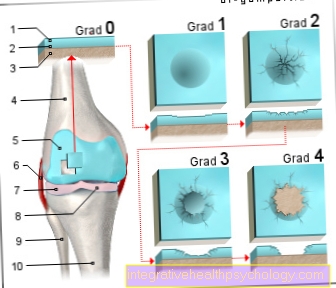Lung cancer therapy
Synonyms
Lung cancer, lung carcinoma, bronchial carcinoma, small cell lung cancer, squamous cell carcinoma, large cell lung cancer, adenocarcinoma, Pancost tumor, NSCLC: Non small cell lung cancer, SCLC: Small cell lung cancer, oat cell cancer
The histology (tissue examination) is decisive for the choice of therapy.
Non-small cell lung cancer
In this form of cancer, surgery is the most important therapy. However, surgery is not always possible, depending on the patient's health and the stage of the tumor. The patient's lung function is therefore tested before an operation, e.g. the proportion of the affected lung in the total respiratory performance can be checked. This proportion must not be too large, otherwise the oxygen supply to the body would be at risk after the operation (see breathing).
In addition, so-called anatomical inoperability can exist if the tumor has advanced too far. In the presence of metastases, involvement of both lungs or the trachea and the tumor growing into other organs such as e.g. the heart can no longer be operated on, or only in exceptional cases. This is the case from stage IV, in stage III it is further subdivided into stage IIIb, here an operation is not possible, except in special cases after previous chemotherapy and radiation therapy, and stage IIIa, here an operation may be possible.
If operability is given, a lobectomy or pneumectomy is performed, i.e. either a lobe of the lung or an entire lung is removed. (For the anatomy of the lungs see here). During the operation, lymph nodes will also be removed to see if they have lung cancer. Healing can only be achieved through complete removal of the tumor tissue; the operation achieves the best effect here.
In the event of inoperability, radiation therapy or chemotherapy (therapy with substances that inhibit cell growth) can be carried out, although the patient's state of health can limit the possible uses of the therapy. With radiation therapy, a cure is only achieved in approx. 10% of the cases, but tumor growth can usually be delayed. Chemotherapy can improve the prognosis with an improved quality of life, but only around 30% of patients respond to the therapy. A cure is not to be expected.
Read the article on this: Chemotherapy side effects lung cancer.
At this point we would like to refer you to our main page on squamous cell carcinoma of the lung. You will find further important information on this at: Squamous cell carcinoma of the lungs
Note
All information given here is only of a general nature, tumor therapy always belongs in the hands of an experienced oncologist (tumor specialist)!
Illustration of the lungs

- Right lung -
Pulmodexter - Left lung -
Pulmo sinister - Nasal cavity - Cavitas nasi
- Oral cavity - Cavitas oris
- Throat - Pharynx
- Larynx - larynx
- Windpipe (approx. 20 cm) - Trachea
- Bifurcation of the windpipe -
Bifurcatio tracheae - Right main bronchus -
Bronchus principalis dexter - Left main bronchus -
Bronchus principalis sinister - Lung tip - Apex pulmonis
- Upper lobe - Superior lobe
- Inclined lung cleft -
Fissura obliqua - Lower lobe -
Inferior lobe - Lower edge of the lung -
Margo inferior - Middle lobe -
Lobe medius
(only on the right lung) - Horizontal cleft lung
(between upper and middle lobes on the right) -
Horizontal fissure
You can find an overview of all Dr-Gumpert images at: medical illustrations
Small cell lung cancer
In the case of small cell bronchial carcinoma, the opposite is the case chemotherapy in the foreground. On the one hand, the extremely fast-growing cells of this type of tumor are more sensitive to specific growth-inhibiting therapies such as radiation or chemotherapy, i.e. the response rates are higher than for non-small cell lung cancer, and on the other hand, metastasis has usually already occurred at the time of diagnosis, which is why a therapy must be selected that affects all cells of the body.
The cure rates of a combination chemotherapy (several drugs, in this case called cytostatics, are used) are 60% - 90% for the "limited disease" (but only 35% of the diagnoses) and 30% - 80% for the "extending disease "(65% of diagnoses).
In addition to chemotherapy, radiation is usually given to the brain to prevent the tumor from spreading (prophylactic cranial irradiation). Metastases are often the first to be found in the brain. In rare cases, small cell lung cancer in the "limited disease" stage can be operated on with subsequent chemotherapy.
To relieve discomfort caused by metastasis of the tumor in other parts of the body such as the brain or the bones, especially that Spine local radiation therapy can be performed.
Note: therapy options
Treatment for lung cancer depends on the stage of the disease, the patient's health, and many other factors. The “standard therapies” mentioned here are therefore only indicative; the decision on the “right” therapy must be made on a case-by-case basis. The treatment of bronchial carcinoma belongs in the hands of a specialist!
To find better therapies for cancer patients, there are clinical studies whose treatments are based on the latest research findings. Before starting therapy, the attending physician can determine whether there is an option to participate in one of the ongoing studies, if the patient so wishes.
forecast
The prognosis for lung cancer is poor. Only about 1/3 of patients with non-small cell lung cancer are operable. After an operation 40-60% of the patients live longer than five years, without an operation only 20-30%.
In small cell lung cancer, the mean survival time without therapy is 4-5 months, after chemotherapy 8-12 months (extensive disease) or 12-16 months (limited disease).
If curative therapy is no longer possible, palliative therapy for lung cancer can be considered. This is primarily aimed at improving the quality of life and relieving the symptoms.





























